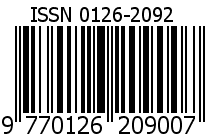Potensi nanopartikel chitosan berbasis flavonoid fisetin dari buah stroberi (Fragaria x ananassa): modalitas terapi dalam penatalaksanaan TNBC
Abstract
Keywords
Full Text:
PDFReferences
Jiao Q, Wu A, Shao G, Peng H, Wang M, Ji S, Liu P, Zhang J. The latest progress in research on Triple Negative Breast Cancer (TNBC): Risk Factors, Possible Therapeutic Targets and Prognostic Markers. A Review of Triple Negative Breast Cancer. 2014; 6(9):1329-1335
Tao ZQ, Shi A, Lu C, Song T, Zhang Z, Zhao J. Breast Cancer: Epidemiology and Etiology. Cell Biochem Biophys. 2015; 72:333338
Verma R, Lowen RL, Slater SE, Mihaimeed F, Jones JL. Pathological and Epidemiological Factors Associated with Advanced Stage at Diagnosis of Breast Cancer. British Medical Bulletin. 2012; 103:129-145
The Cancer Genome Atlas Network. Comprehensice Molecular Portraits of Human Breast Tumours. Nature. 2012. 490: 61-70
Bianchini G, Balko JM, Mayer IA, Sanders ME, Gianni L. Triplenegative Breast Cancer: Challenges and Opportunities of Heterogeneous Disease. Clinical Oncology. 2016; 13: 674-690
Foulkes WD, Smith IE, ReishFilho JS. Triple-negative Breast Cancer. The New England Journal of Medicine. 2010; 363:1938-1948
Reis-Filho JS, Tutt ANJ. Triple Negative Tumours: A Critical Review. Histopathology. 2008; 52:108-118
Ruijter CD, Veeck J, Hoon JPJ, Engeland M, Tjan-Heijnen VC. Characteristics of Triple-Negative Breast Cancer. Journal Cancer Res Clinical Oncology. 2011; 137: 183-192
American Cancer Society. Breast Cancer: Facts & Figures 20172018. Atlanta: American Cancer Society, Inc. 2017
O’Reilly EA, Gubbins L, Sharma S, Tully R, Guang MHZ. The Fate of Chemoresistance in Triple Negative Breast Cancer (TNBC). BBA Clinical.2015;3:257-275
Khan N, Afaw F, Mukhtar H. Cancer Chemoprevention Through Dietary Antioxidants Progress and Promise. Antioxidants & Redox Signaling. 2008: 10(3): 475-510
Khan N, Syed DN, Ahmad N, Mukhtar H. Fisetin: A Dietary Antioxidant for Health Promotion. 2013; 19(2): 151-162
Cavalli R, Bisazza A, Trotta M, Argenziano M, Civra A. New chitosan nanobubbles for ultrasound- mediated gene delivery : preparation and in vitro characterization. 2012
Yang W, Peters JI, Williams RO. Inhaled nanoparticles — A current review. 2008;356:239–47
Liu X, Chem JM, Xue X, Liu X. Emerging functional nanomaterials for therapeutics. 2011;21(35).
Malorni L, Shetty PB, Angelis CD, Hilsenbeck S, RImawi MF, Elledge R, Osborne CK, Placido SD, Arpino G. Clinical and Biologic Features of TripleNegative Breast Cancers in A Large Cohort of Patients with Long-Term Follow-Up. Breast Cancer Res Treat. 2012;136(3):795-804
Bosch A, Eroles P, Zaragoza R, Vina JR, Lluch A. Triple-Negative Breast Cancer: Molecular Features, Pathogenesis, Treatment and Current Lines of Research. Cancer Treatment Reviews.2010;36:206-215
Kimira M, Arai Y, Shimoi K, and Watanabe S. Japanese intake of flavonoids and isoflavonoids from foods. J Epidemiol 8: 168–175, 1998
Y.S. Touil, N. Auzeil, F. Boulinguez, H. Saighi, A. Regazzetti, D. Scherman, et al., Fisetin disposition and metabolism in mice: identification of geraldol as an active metabolite, Biochem. Pharmacol. 82 (2011) 1731–1739
Smith ML, Murphy K, Doucette CD, Greenshields AL, Hoskin DW. The Dietary Flavonoid Fisetin Causes Cell Cycle Arrest, Caspase-Dependent Apoptosis, and Enhanced Cytotoxicity of Chemotherapeutic Drugs in Triple-Negative Breast Cancer Cells. Journal of Cellular Biochemistry.2016; 117: 19131925
Syed DN, Adhami VM, Khan N, Khan MI, Mukhtar H. Exploring the Molecular Targets of Dietary Flavonoid Fisetin in Cancer. Seminars in Cancer Biology. 2016;40-41:130-140
Indran IR, Tufo G, Pervais S, Brenner C. Recent Advances in apoptosis, Mitochondria, and Drug Resistance in Cancer Cells. Biochimica et Biophysica Acta. 2011: 735-745
Elmore S. Apoptosis: A Review of Programmed Cell Death. Toxicol Pathol. 2007; 35(4):495-516
Prigent C, Dimitrov S. Phosphorylation of Serine 10 in Histone H3, What for?. Journal of Cell Science. 2013; 116: 36773685
Ham SL, Nasrollahi S, Shah KN,, Soltisz SP, Yun YH, Luker GD, Bishayee A, Tavana H. Phytochemicals potently inhibit migration of metastatic Breast Cancer Cells. Integrative Biology.2015;7(7):792-800





















